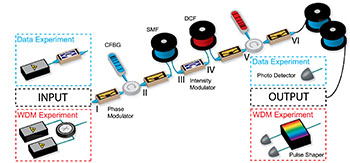
Experimental setups used for the multiwavelength cloak (“WDM”) and corrupted-signal recovery (“Data”) experiments. CFBG, chirped fiber Bragg grating; SMF, single-mode fiber; DCF, dispersion-compensating fiber. [Image: Lukens et al., Optica 1, 372 (2014)]
In addition to spatial “invisibility cloaks” that hide objects—often using approaches involving exotic metamaterials—researchers in recent years have experimented with so-called temporal cloaking, which can hide events in time in an optical data stream. Such space-time cloaks, which have yet to be fully realized, have obvious applications in security and defense, for corrupting or hiding a data stream. A team of U.S. scientists has now demonstrated how temporal cloaking can actually be used differently, to improve data transmission in certain circumstances (Optica, doi: 10.1364/OPTICA.1.000372).
Temporal cloaks work by manipulating the optical signal—for example, speeding up the front of a probe light beam and slowing down its rear part using dispersive elements—and thereby opening up a “time hole” or gap, analogous to the “hole in space” created by optical spatial cloaks. An event lodged in the temporal gap thus becomes invisible to an observer. Thus far, however, such cloaks have hidden events in the time hole from all observers, rather than just unwanted eavesdroppers, and have been tested only on continuous-wave fields. Extending space-time cloaks to noncontinuous-wave fields would open up the possibility of using temporal cloaking to clean up a signal that had been corrupted or tampered with.
A team led by Andrew Weiner of Purdue University, Ind., USA, has now demonstrated an approach that gets past some of these shortcomings. In one experiment, they sent a multiwavelength, or wavelength division multiplexed (WDM), pulse train from two independent single-wavelength lasers through a fiber system, introducing a data signal into the light through intensity modulation. When the temporal cloak—operating through an array of phase modulators and dispersive elements—was turned on, the data was hidden in one wavelength channel, while fully transmitted in the other wavelength channel. Thus, in principle, the cloak allows information to be masked from one observer and directed to another.
In a second experiment, the team used a single-frequency continuous-wave laser as the data source, and jumbled the data by modulating the laser light at various fractions of the clock frequency. When the phase modulators that activate the cloaking system are turned off, these high-speed corrupting events destroy the original input data signal; when the cloak is turned on, the distorting modulation disappears into the cloak’s temporal hole, allowing the input signal to be recovered at the output.
The researchers see opportunities to improve the system by tweaking the optical elements to reduce drift and, more generally, to extend the system to arbitrary laser frequencies rather than the carefully chosen ones used for this proof of principle. Still, they conclude in the paper, the two experiments “offer new perspectives on temporal cloaking for improving data communication systems rather than disturbing them.”

